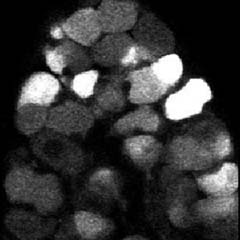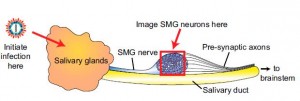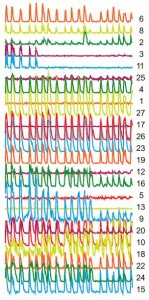By Catherine Zandonella, Office of the Dean for Research
Hepatitis C affects about three million people in the U.S. and is a leading cause of chronic liver disease, so creating a vaccine and new treatments is an important public health goal. Most research to date has been done in chimpanzees because they are one of a handful of species that become infected and spread the virus.
Now researchers led by Alexander Ploss of Princeton University and Charles Rice of the Rockefeller University have generated a mouse that can become infected with hepatitis C virus (HCV). They reported the advance in the Sept 12 issue of the journal Nature. “The entire life cycle of the virus — from infection of liver cells to viral replication, assembly of new particles, and release from the infected cell — occurs in these mice,” said Ploss, who joined the Princeton faculty in July 2013 as assistant professor of molecular biology.
Ploss and his colleagues have been working for some time on the challenge of creating a small animal model for studying the disease. Four years ago, while at the Rockefeller University in New York, Ploss and Rice identified two human proteins, known as CD81 and occludin, that enable mouse cells to become infected with HCV (Nature 2009). In a follow up study Ploss and colleagues showed that a mouse engineered to express these human proteins could become infected with HCV, although the animals could not spread the virus (Nature 2011).
In the present study, which included colleagues at Osaka University and the Scripps Research Institute, the researchers bred the human-protein-containing mice with another strain that had a defective immune system – one that could not easily rid the body of viruses. The resulting mice not only become infected, but could potentially pass the virus to other susceptible mice.
The availability of this new way to study HCV could help researchers discover new vaccines and treatments, although Ploss cautioned that more work needs to be done to refine the model.
The study was supported in part by award number RC1DK087193 from the National Institute of Diabetes and Digestive and Kidney Diseases; R01AI072613, R01AI099284, and R01AI079031 from the National Institute for Allergy and Infectious Disease; R01CA057973 from the National Cancer Institute; and several foundations and contributors, as well as the Infectious Disease Society of America and the American Liver Foundation.
Marcus Dorner, Joshua A. Horwitz, Bridget M. Donovan, Rachael N. Labitt, William C. Budell, Tamar Friling, Alexander Vogt, Maria Teresa Catanese, Takashi Satoh, Taro Kawai, Shizuo Akira, Mansun Law, Charles Rice & Alexander Ploss. 2013. Completion of the entire hepatitis C virus life cycle in genetically humanized mice. Nature 501, 237–241 (First published online on 31 July 2013) doi:10.1038/nature12427.




You must be logged in to post a comment.